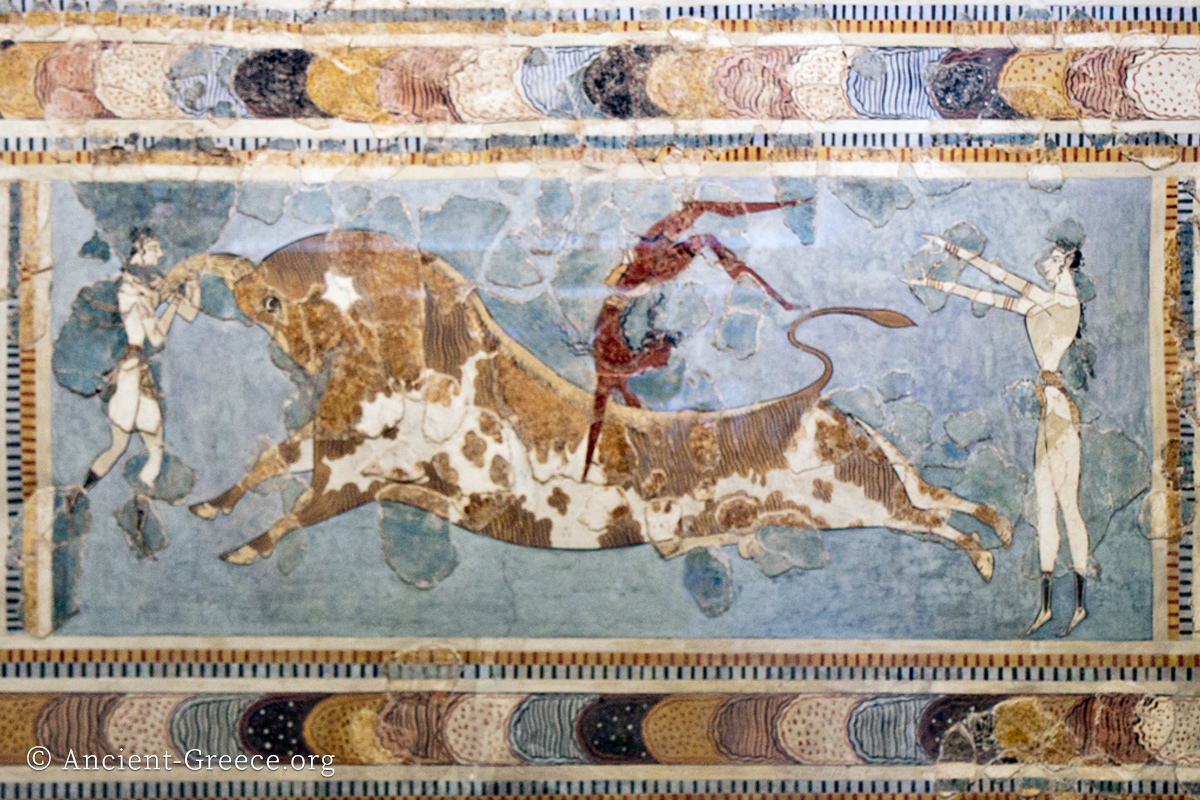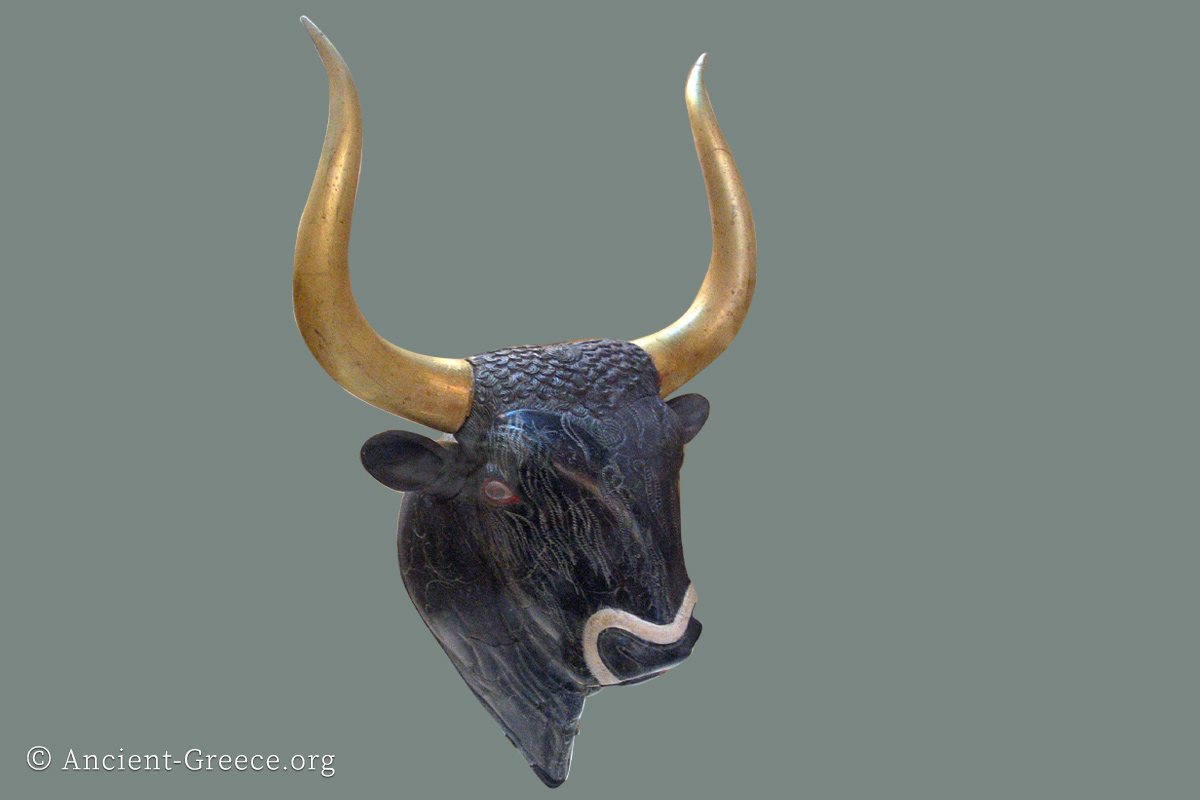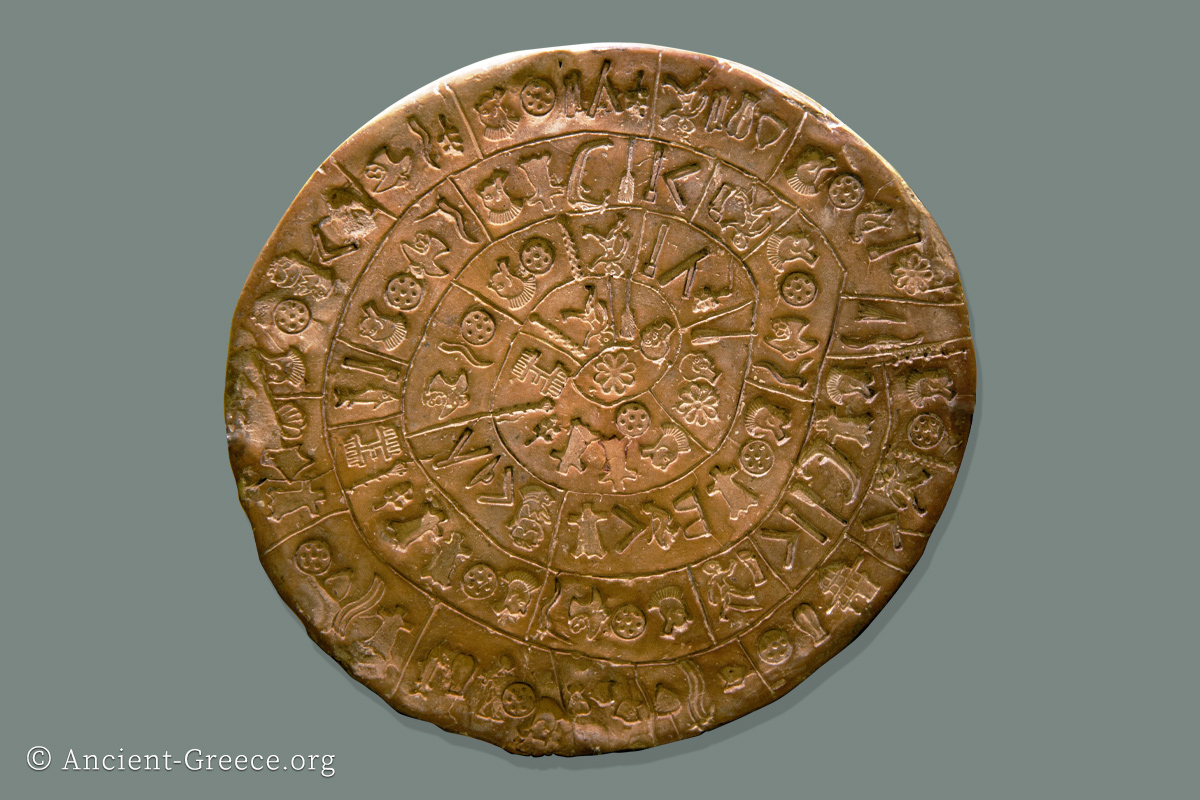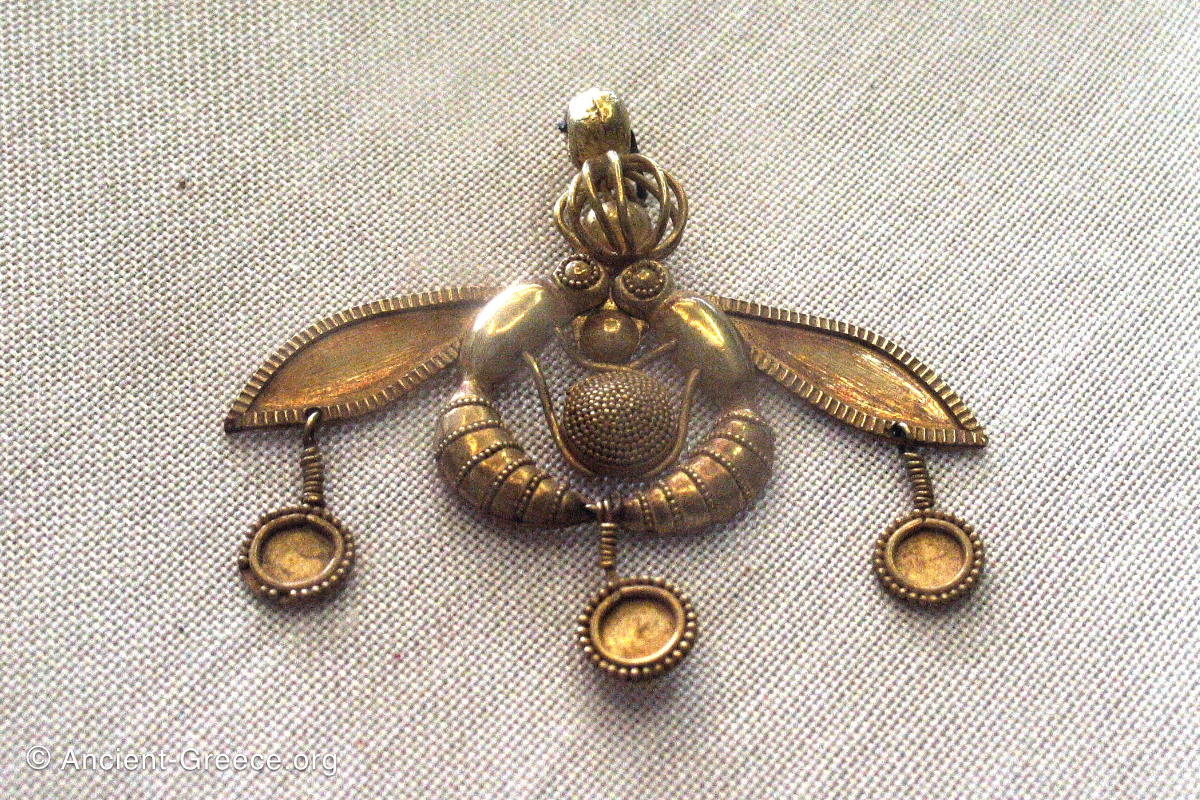
On this page:
One of the most important museums of Greece, the Heraklion Archaeological Museum (Αρχαιολογικό Μουσείο Ηρακλείου) displays artifacts from the numerous archaeological sites of Crete.
The exhibitions span several millennia, beginning with finds from paleolithic Crete, and ending in the Roman era.
Highlights of the museum exhibitions include major finds from Minoan palaces in Crete: several ceremonial rhytons, wall frescoes, Kamares pottery, sculptures from Stone Age to Roman, and every-day artifacts, and gold jewelry that provide a glimpse into life in the Bronze Age civilization we call Minoan.
Minoan Stone Vessels
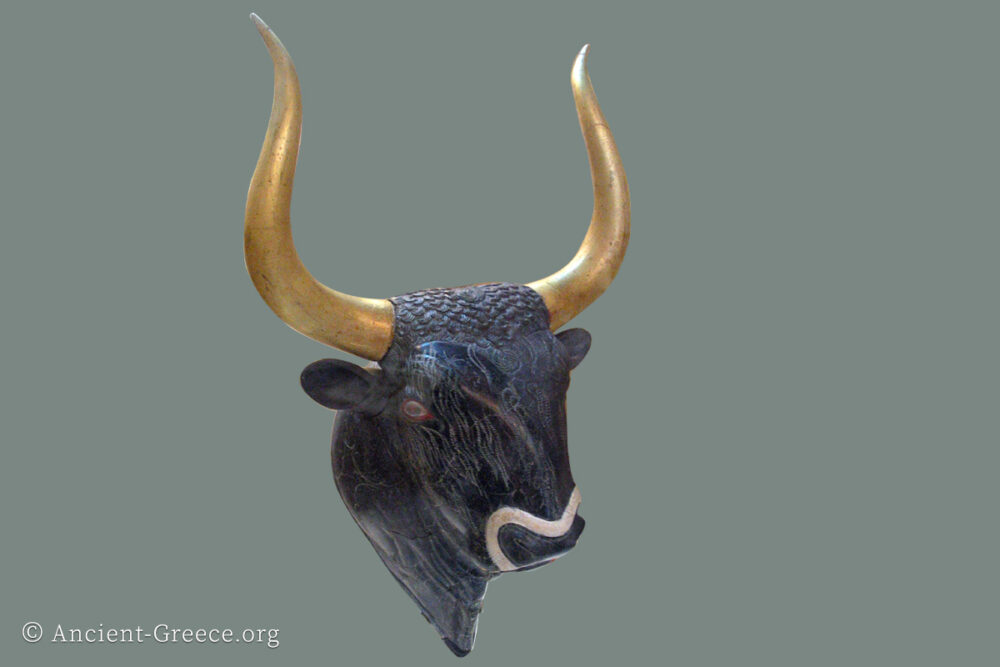
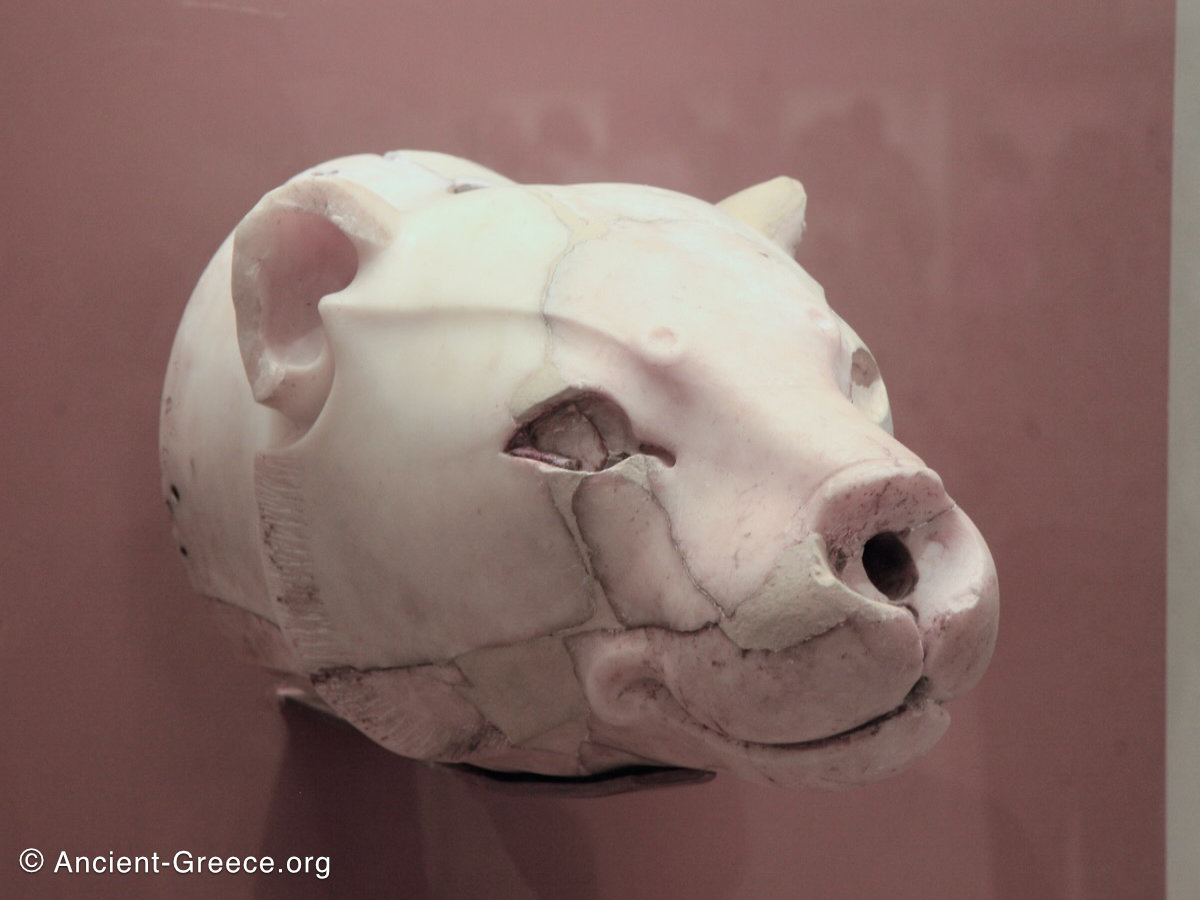

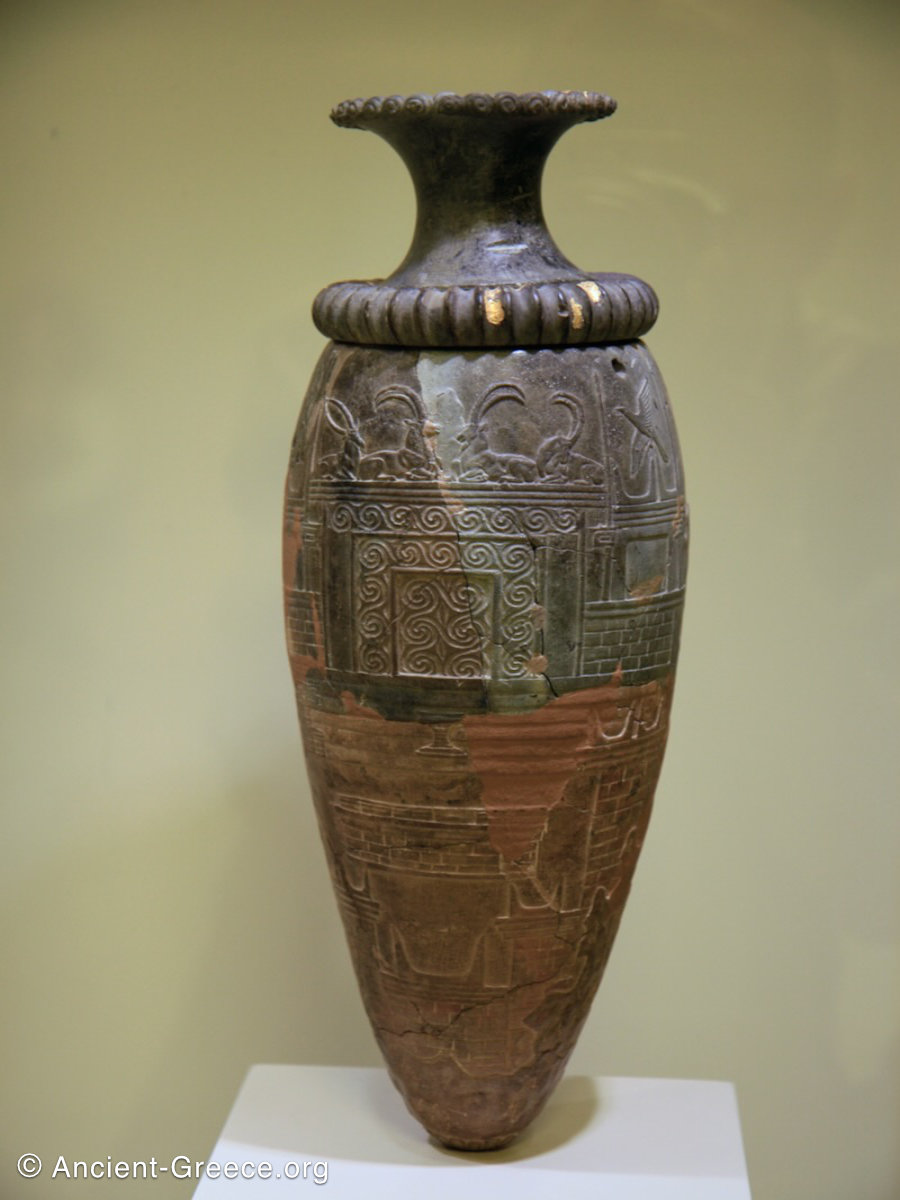
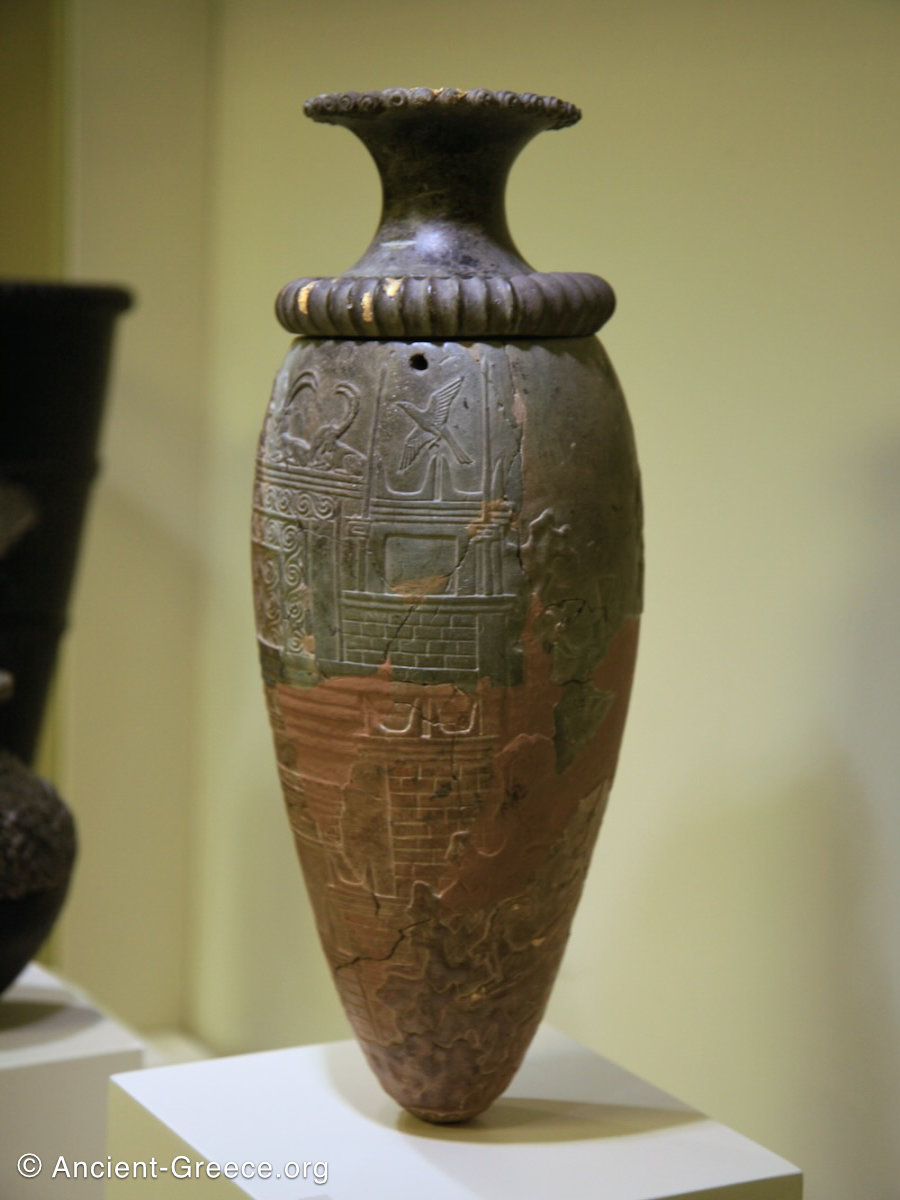

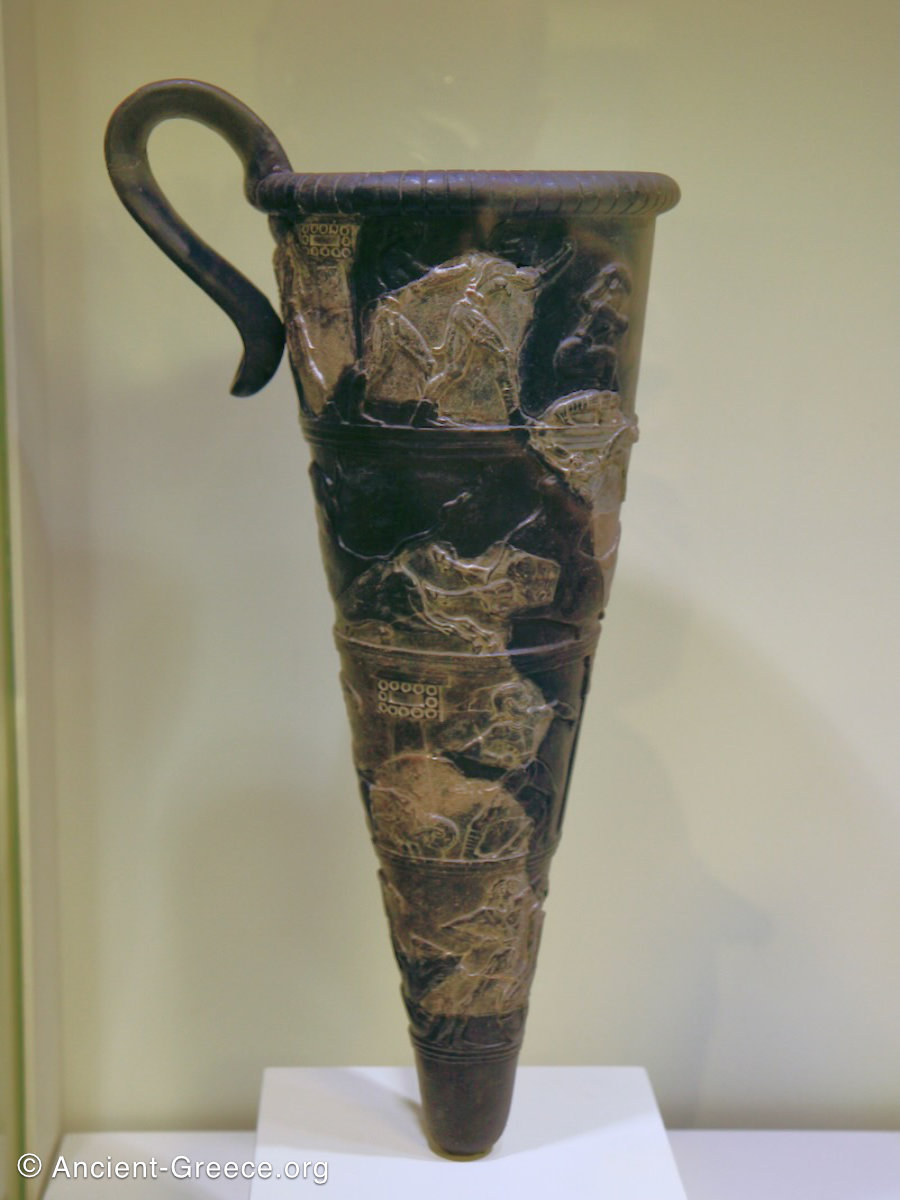


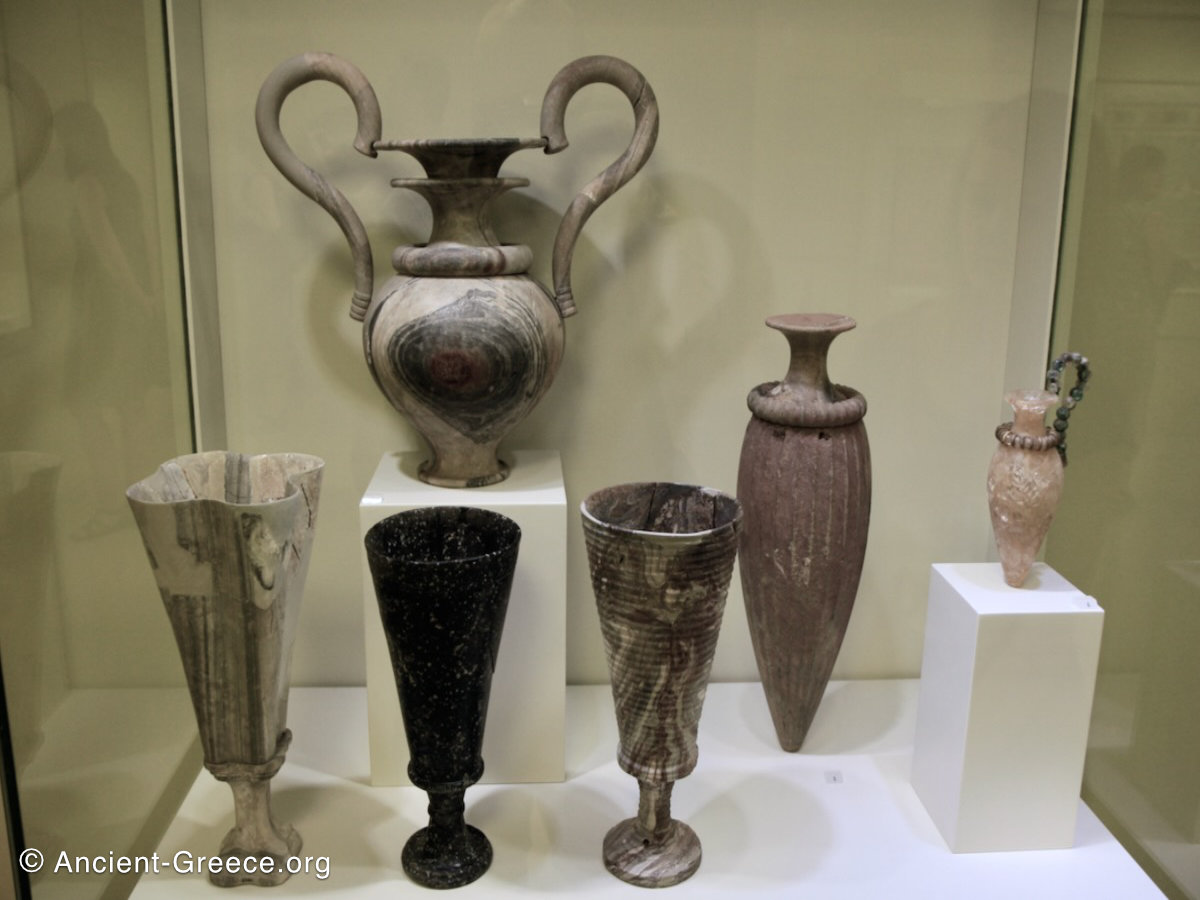
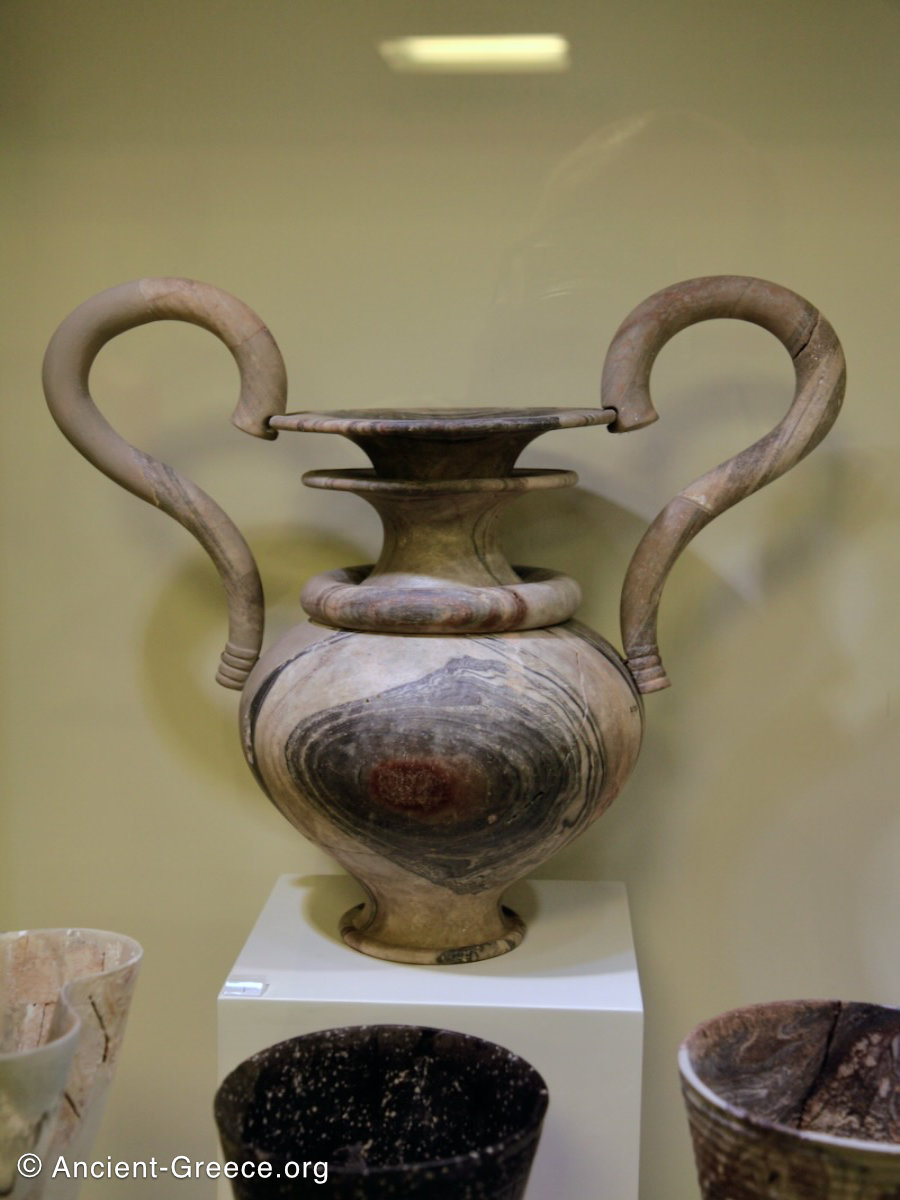
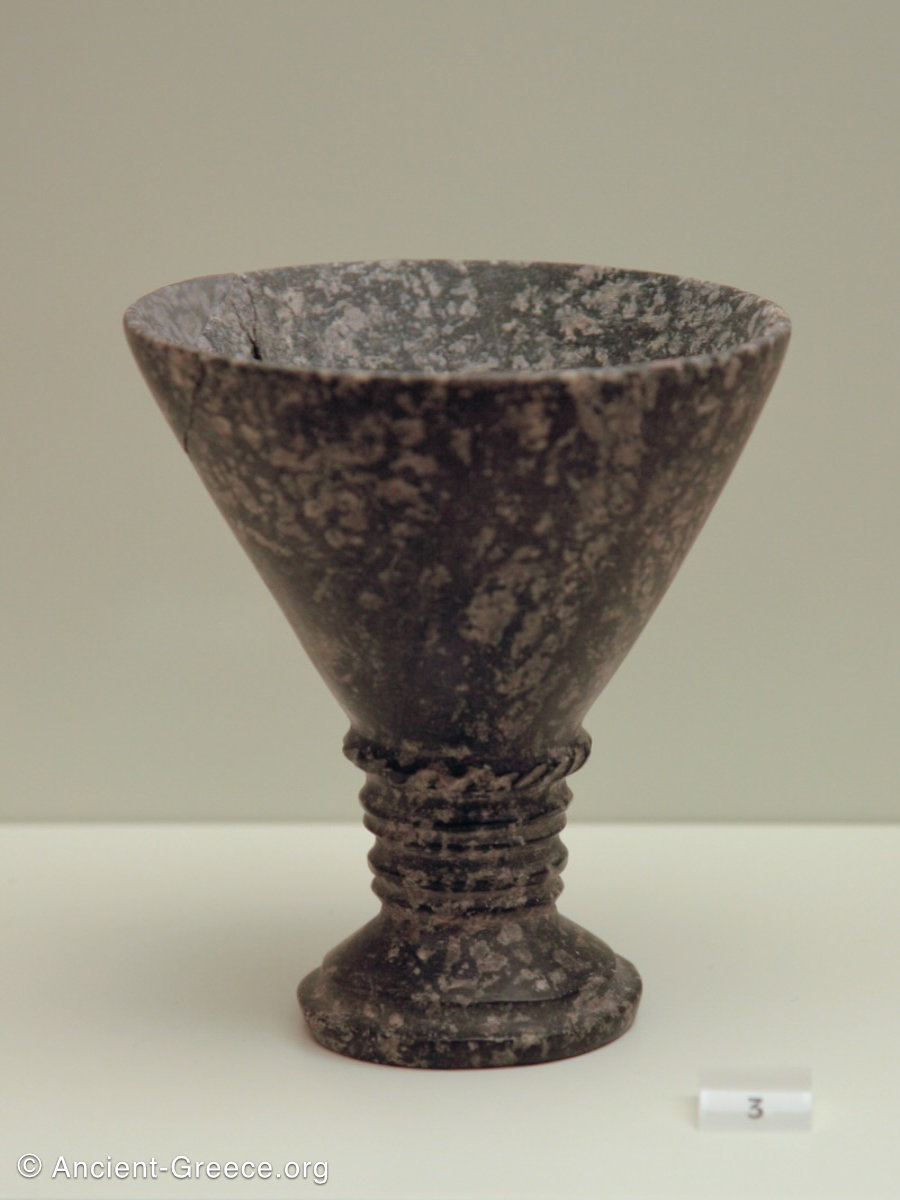
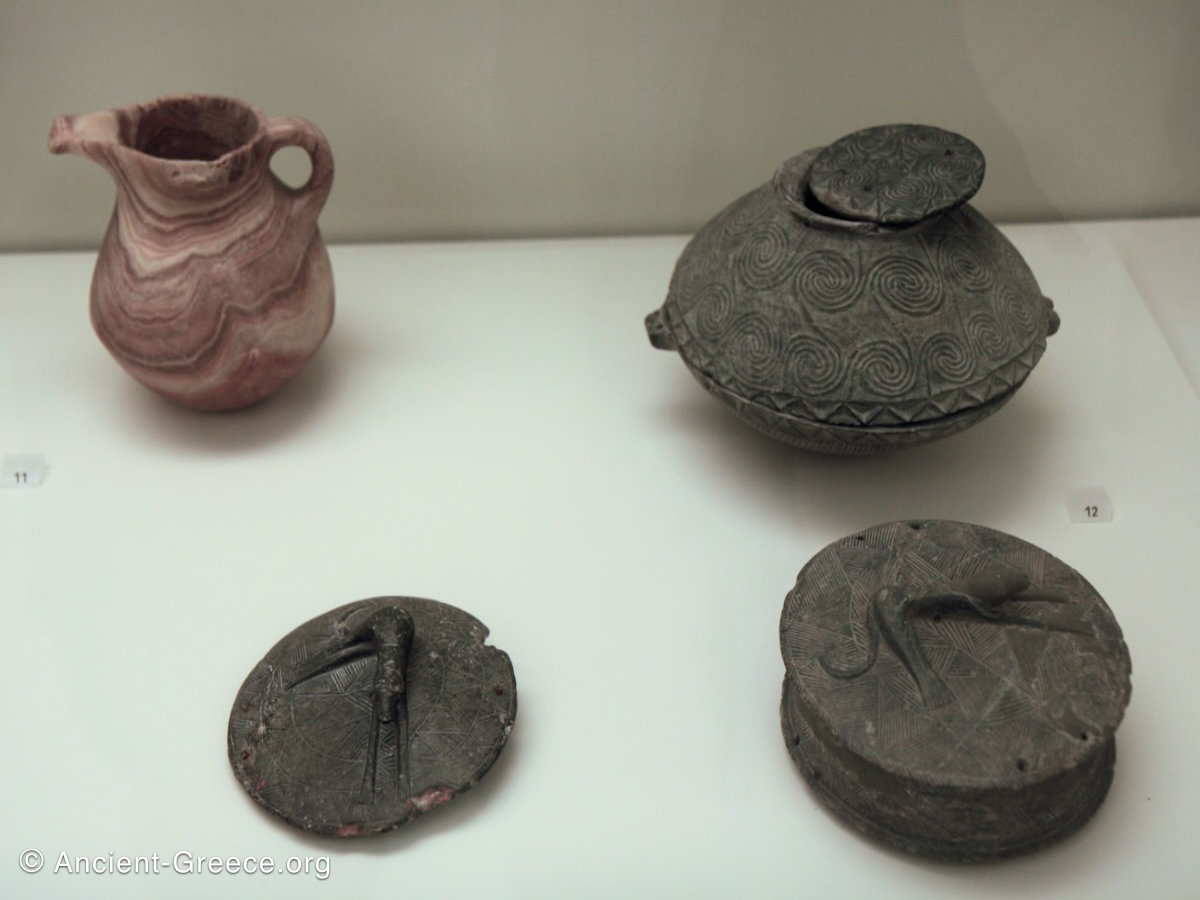
Included in these photos (click each for more details):
Bull Rython from Knossos: Rython (libation vase) in the shape of a bull’s head. Made of serpentine, with inlays of shell, rock crystal and jasper in the muzzle and eyes. Found in Knossos Minoan palace, in the temple repository. New-Palace period, 1600 – 1500 BCE.
Lion’s-head rhyton. Limestone. From the palace of Knossos. Minoan Neopalatial period, 1600 – 1450 BCE.
Rock Crystal rhyton. From Zakros palace. Made of rock crystal. 1500 – 1450 BCE.
Rhyton with relief decoration of mountain shrine. From Zakros palace. Pieces of the gold leaf surface are still visible on the neck. Minoan Neopalatial period, 1500 – 1450 BCE.
Harvester Vase (or Harvester Rhyton), Steatite, 1500-1450 BCE.
The Harvester Vase is a rhyton from Bronze Age Crete, Greece, unearthed in the Minoan villa known as Agia Triada. It was made of steatite, which is a green-brown soapstone. A low relief depicting a group of workers walking to, or returning from olive harvest is carved on a continuous band across its face. It was originally gilded with gold hammered to paper-thin thickness (gold leaf).
Boxer Vase: Steatite Conical Rhyton with Depictions of wrestling, boxing, bull-leaping. From Hagia-Triada. Minoan Neopalatial period, 1700-1450 BC.
Stone rhytons from Zakros palace. Minoan Neopalatial period, 1525 – 1450 BCE.
Double-handled ritual amphora. Limestone. 1500 – 1450 BCE.
Porphyry rhyton. Porphyry stone. 1525 – 1450 BCE.
Rock Crystal rhyton. Made of rock crystal. 1500 – 1450 BCE.
Double-handled ritual amphora. Zakros palace. Limestone. 1500 – 1450 BCE.
Porphyry rhyton. From Zarkos palace. Made of porphyry stone. 1525 – 1450 BCE.
Minoan Stone Vessel with Lid.
Stone chalice from Zakros. Neopalatial period, 1525/1500-1450 BCE.
Minoan stone vessels and Pyxis with reclining dog decoration. From Zakros palace. Minoan Prepalatial period, 2700 – 2200 BCE.
Minoan Statuettes
Top row, left to right:
- Clay seated female figurine. From Pano Chorio Ierapetra. Middle-Late Neolithic period, 5800-4800 BCE.2
- Cycladic figurines with folded arms. from Koumasa, Crete. 2700-2400 BCE.
- Ivory bull-leaper figurine. From Knossos palace. Minoan Neopalatial period. 1600-1500 BCE.
- Minoan Snake Goddess figurine from Knossos palace. Neopalatial period, 1650 – 1550 BCE
Middle row, left to right:
- Sceptre head. One and is shaped like a leaping panther, the other as an axe. From Malia palace. Protopalatial period, c. 1700 BCE.
- Minoan Snake Goddess figurine from Knossos palace. Neopalatial period, 1650 – 1550 BCE.
- Minoan Statuettes.
- Female figurnine rhytons. From Mochlos, Crete. Minoan Prepalatial period, 2600-2100 BCE.
- Clay Figurines
Bottom row, left to right:
- Clay donkey with jugs statuette.
- Clay donkey with jugs statuette.
- Minoan Clay Figurines. Minoan Protopalatial period, 1800-1650 BCE.
- Clay statuette group of musician and circle dancers. 1400-1300 BCE.
- Clay statuette of figures dancing in a circle. 1700-1600 BCE.
- A collection of clay figures of goddess with upraised arms. 1300-1200 BCE.
Minoan Jewelry
Top row, clockwise:
- Minoan Gold Jewelry. 1700-1400 BCE.
20-22: Gold earrings in the shape of a bucranium with gold granulation. Knossos. (1450-1350 BC)
23-25: Necklace of gold beads in the shape of papyrus, ivy leaves and confronted argonauts. Sellopoulo, Knossos. (1400-1350 BC) - Jewelry from the Harbor of Knossos, Poros, Heraklion, Crete. 17th-15th c. BCE.
- Gold double axes. From Arkalochori cave in Crete island. Neopalatial period, 1700 – 1450 BCE.
Bottom row:
- Gold pendant with two bees. from Chryssolakos burial complex at Malia palace. Minoan Protopalatial period, 1800 – 1700 BCE.
Cast gold with gold granules soldered on the surface.
Found at Chrysolakos at Malia. The two bees arranged symmetrically around a drop of honey. Protopalatial Period, 4.6 cm high (1 13/16″) - Gold signet ring known as “Ring of Minos”. With cult “ehiphany” scene. 1450-1400 BCE.
Minoan Frescoes
First row, left to right:
- La Parisienne fresco, also known as the Minoan Lady. 1450-1350/1300 BCE.
- Lily fresco from the Amnissos Minoan villa. 1600-1500 BCE.
- Fresco with lilies and reed
Second row:
- Procession fresco fragment from Knossos palace. 1450-1400 BCE.
- Figure-of-Eight Shields fresco from Knossos palace. Late Minoan II (Final palatial period), 1450-1400 BCE.
- Sacred Grove and Dance fresco. Knossos palace. Minoan. 1600-1500 BCE.
- Tripartite Shrine fresco (Grandstand fresco) from the Minoan palace of Knossos. 1600-1500 BCE.
- 5-7 Minoan fresco fragments.
Third row:
- 1-3: Minoan fresco fragments.
- Prince of Lilies relief fresco from the Minoan palace of Knossos. 1600-1450 BCE.
- Head of a bull relief fresco from the Minoan palace of Knossos. 1650-1550 BCE.
- Ladies in Blue Minoan Fresco Reconstruction from Knossos palace. 1600-1450 BCE.
- Dolphin fresco from Knossos palace. Minoan, 1600-1450 BCE.
ound in a lightwell at the east end of the Queen’s Megaron in the Palace of Knossos.
Fourth row:
- Partridge frieze Fresco detail. Found at Knossos palace. 1600-1450 BCE.
- Partridge Frieze Fresco from Knossos palace. 1600-1450 BCE.
- Minoan fresco of the Garlands. Found at Knossos palace. 1500-1450 BCE.
- Saffron Gatherer fresco with monkeys. From Knossos palace. 1650-1500 BCE.
- Fragments form Minoan Frescoes. 1600-1450 BCE.
6. Head of a blue monkey. 1600-1450 BCE.
7. Ivy stems in a rocky landscape. 1650-1500 BCE.
8. Water elements. 1650-1500 BCE.
9. Myrtle branches. 1650-1500 BCE.
10. Reeds. 1650-1500 BCE. - 6,7: Minoan fresco fragments.
Bottom row:
- 1-3: Cup-bearer fresco from Knossos palace. Final Palatial period, 1450-1400 BCE.Blue Bird Fresco from Knossos palace. Minoan Neopalatial period, 1600-1500 BCE.
- Blue Bird Fresco from Knossos palace. Minoan Neopalatial period, 1600-1500 BCE.
- Dancer Fresco Fragment. From Knossos palace. Minoan Final Palatial Period. 1450-1375 BCE.
- The Bull Leaping fresco from Knossos Palace. Circa 1450 BCE.
The Bull Leaping fresco was originally located in the upper-story portion of the east wall of Knossos palace in Crete. It was excavated in fragments and restored. - Bull Leaping fresco detail.
Agia Triada Sarcophagus
Stone chest larnax known as Agia Triada Sarcophagus. It is covered with fresco scenes of a funerary ritual 1300-1100 BCE.
Minoan Pottery
Top row, left to right:
- Kamares Ware Beaked eye-jug. Found in Phaistos Minoan palace. 1750-1700 BCE.
- Kamares Ware Jug. Protopalatial period, 1750-1700 BCE.
- Krater with Cylindrical Foot and Flowers. Protopalatial period, 1750-1700 BCE.
Second row:
- Pithoid jar with palm trees from Knossos palace. 1600-1450 BCE.
- Jar with fish decoration.
- Minoan rhyton with flower-shaped rim. From Phaistos palace. 1750-1700 BCE.
- Kamares Ware Ceramic jar.
- Kamares Ware bridge-spouted jar. Found at the Minoan Palace of Phaistos. Protopalatial, 1750-1700 BCE.
- Kamares Ware cup. Protopalatial, 1750-1700 BCE.
Third row:
- Kamares Ware cup from Phaistos. Minoan Protopalatial period, 1750-1700 BCE.
- Jug with decoration of reed. From the palace of Phaistos. Minoan Neopalatial period. 1500-1450 BCE.
- Jug with relief and painted Marine Style decoration. 1500-1450 BCE.
- Large Minoan pithos with octopus decoration.
- Ovoid Rhyton with Marine Decoration. From the palace of Phaistos. Neopalatial period, 1500-1450 BCE.
- Minoan pottery jar with marine life decoration.
Bottom row:
- Stirrup jar and flask with octopus. Minoan Neopalatial period. 1500-1450 BCE.
- Clay Pyxis.
- Basket-shaped rhyton with double-axe decoration. From Pseira, Crete. Neopalatial period, 1500-1450 BCE.
- Minoan pottery. Prepalatial period, 2200 – 1900 BCE.
- Large storage pithoi. Early Archaic period, 7th c. BCE.
- Large Minoan pithoi.
Kamares Ware: During the Protopalatial Period (1900-1700 BC) Kamares Ware is the most characteristic style of this period. The pottery style developed in Kamares was characterized by very thin walls, robust swollen curves, elegant spouts and bold decorations. Their beauty made them very popular in Crete as well as in Egypt and Syria where they were exported.
Minoan Artifacts
Top:
The Phaistos Disk: The Phaistos was found in one of the eastern rooms in Phaistos Minoan palace. The script on both of its surfaces resembles hieroglyphs and has not been deciphered yet. It is possibly from the middle or late Minoan Bronze Age.
Second row, left to right:
- Linear B script clay tablets from Knossos. 14-13 c. BCE.
- Linear B script clay tablet from Knossos. 14-13 c. BCE.
- Large double axe. Bronze. Neopalatial period, 1600-1450 BCE.
- A Minoan house model from 17th c. BCE.
Clay house model from Archanes, showing the sophistication of Minoan urban architecture with its functionality and excellent use of living space. It has ample open areas and apertures to maximize natural light and ventilation.
Third row:
- Minoan clay models of house facades.
- Clay Model of Minoan Sacred Building or Altar. From Knossos. Neopalatial period, 1700-1600 BCE.
- Clay Shrine Model. Minoan Neopalatial period. 1700-1600 BCE.
- Minoan Floor Fresco with Geometric Pattern from Phaistos Palace. 1800-1700 BCE.
Fourth row:
- Minoan floor fresco with seascape painting. From Agia Triada shrine. 1400-1370 BCE.
- Fragment of a large bronze stand. Depicts a ship with rowers and warrior. 720-700 BCE.
- Idaean cave bronze drum. 45cm diameter. 730-680 BCE.
- Boar’s-tusk helmet with cheek guards. 1450-1400 BCE.
Bottom row:
- Bronze helmet from Knossos, Venizeleio, Tomb V. Minoan Final Palatial period, 1450-1400 BCE.
- Bronze swords, some with golden handle decorations. Minoan Final Palatial period. 1400-1375 BCE.
- Bronze sword with gold handle. Detail. 1400-1375 BCE.
- Dagger with gold hilt decoration. From Malia palace. Minoan rotopalatial period, 1800 – 1700 BCE.
Classical and Hellenistic Art in Crete

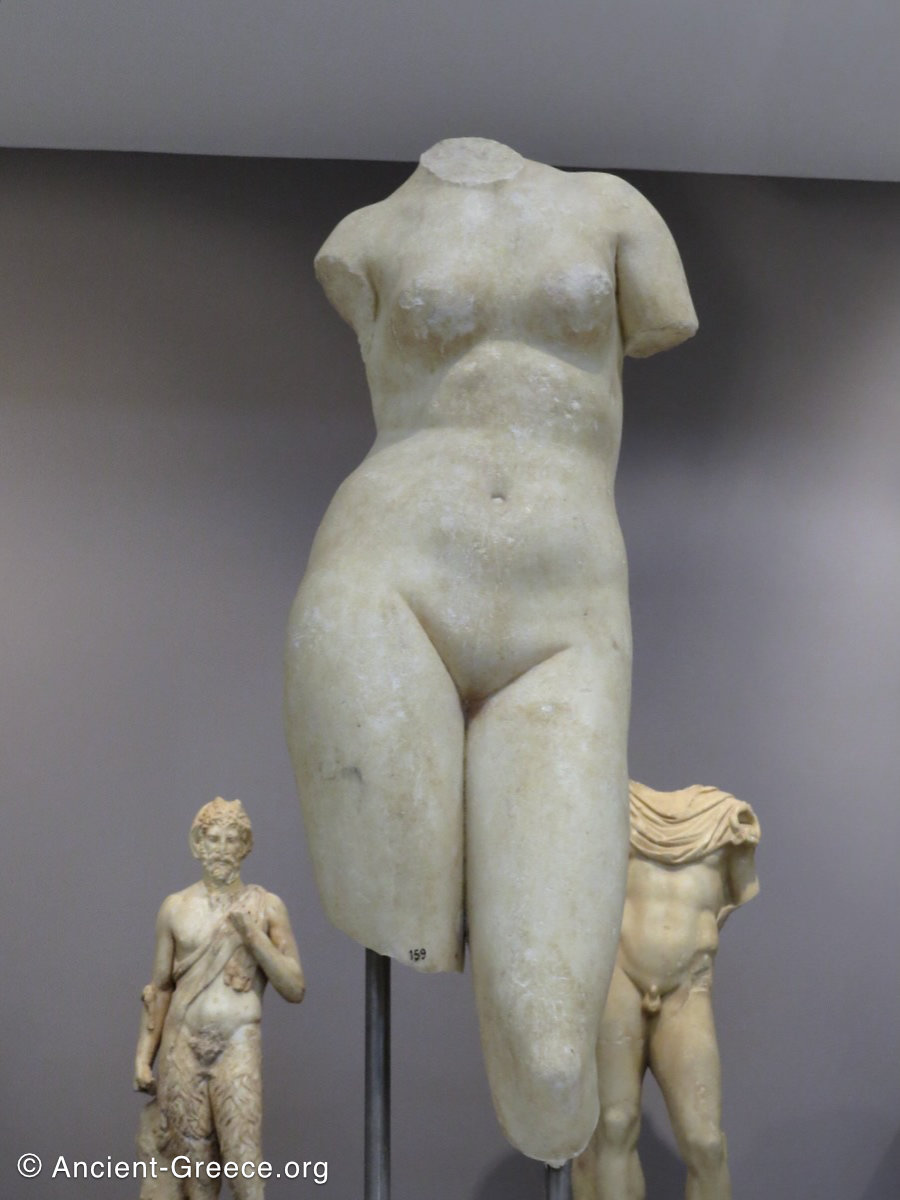



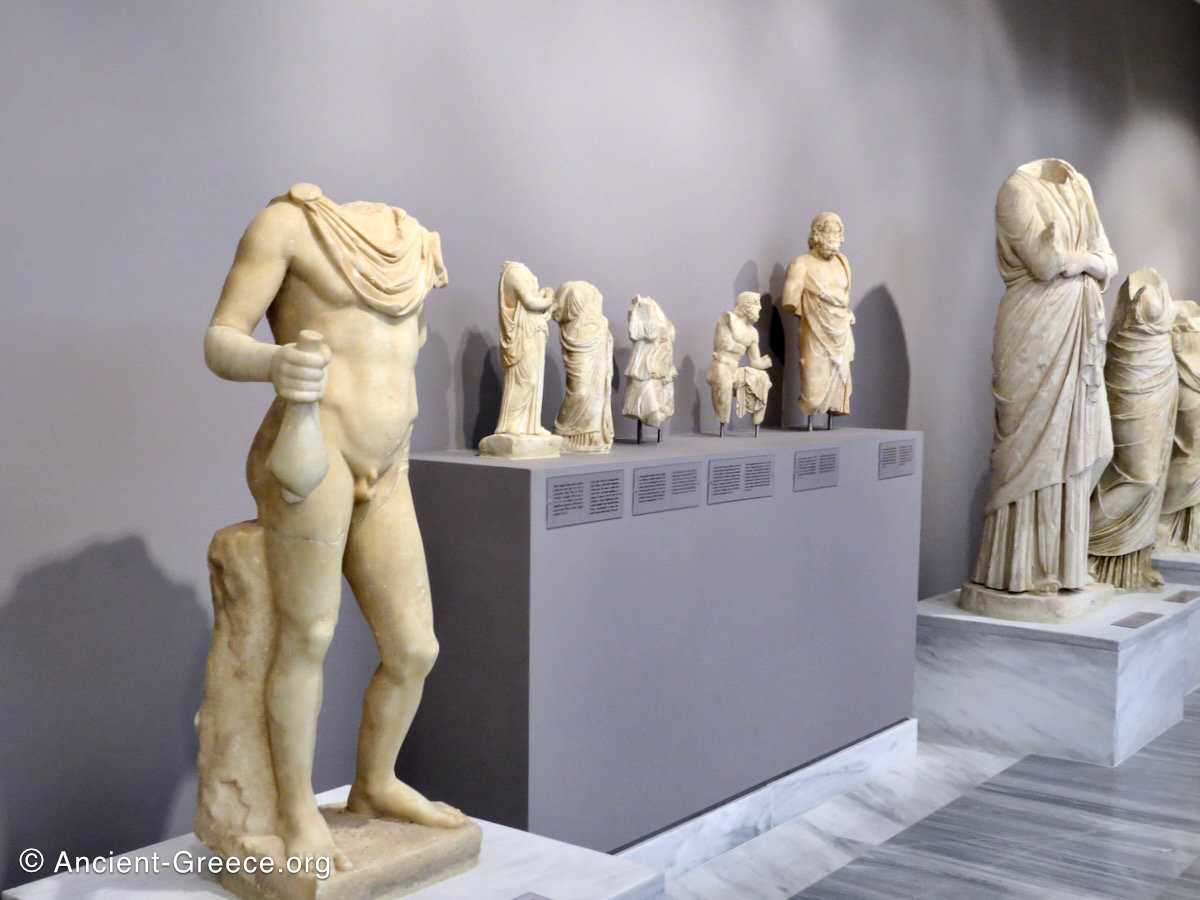
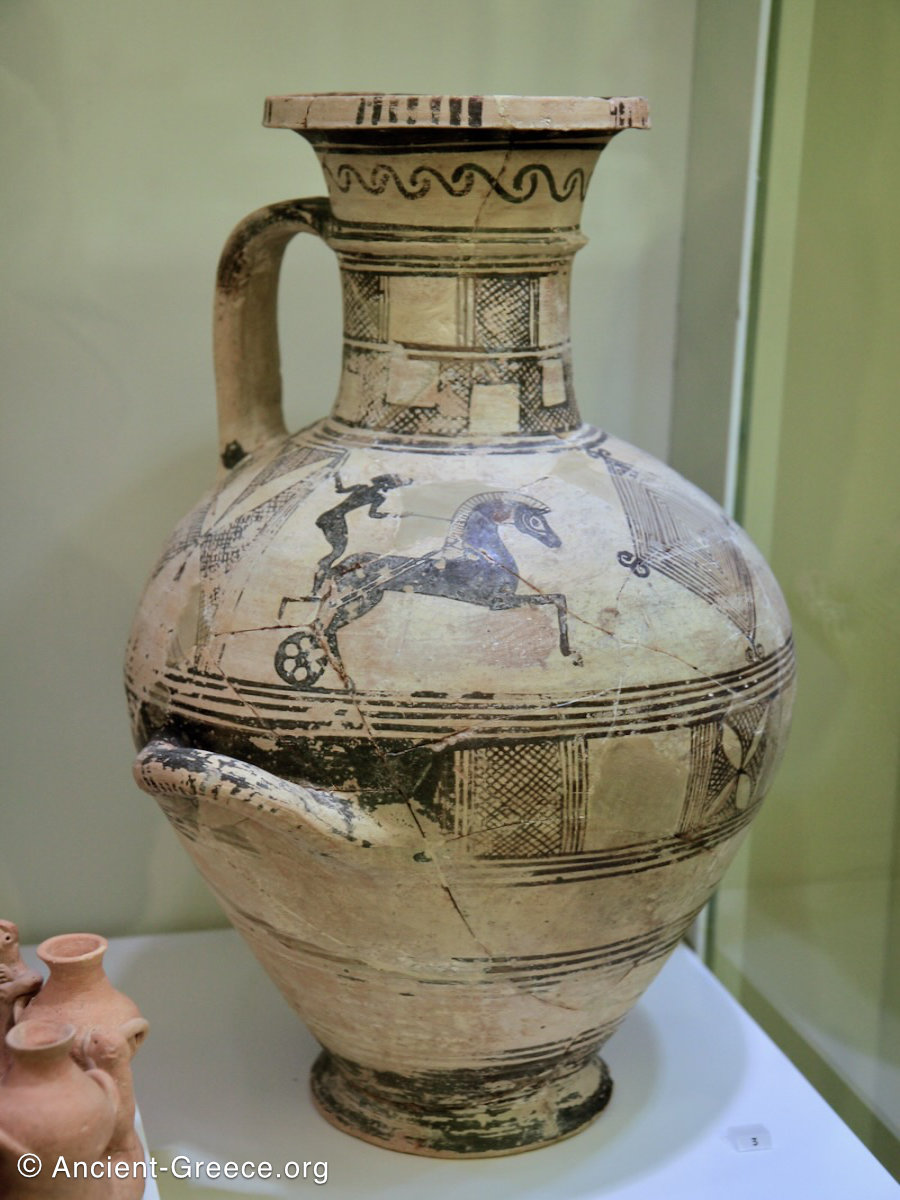
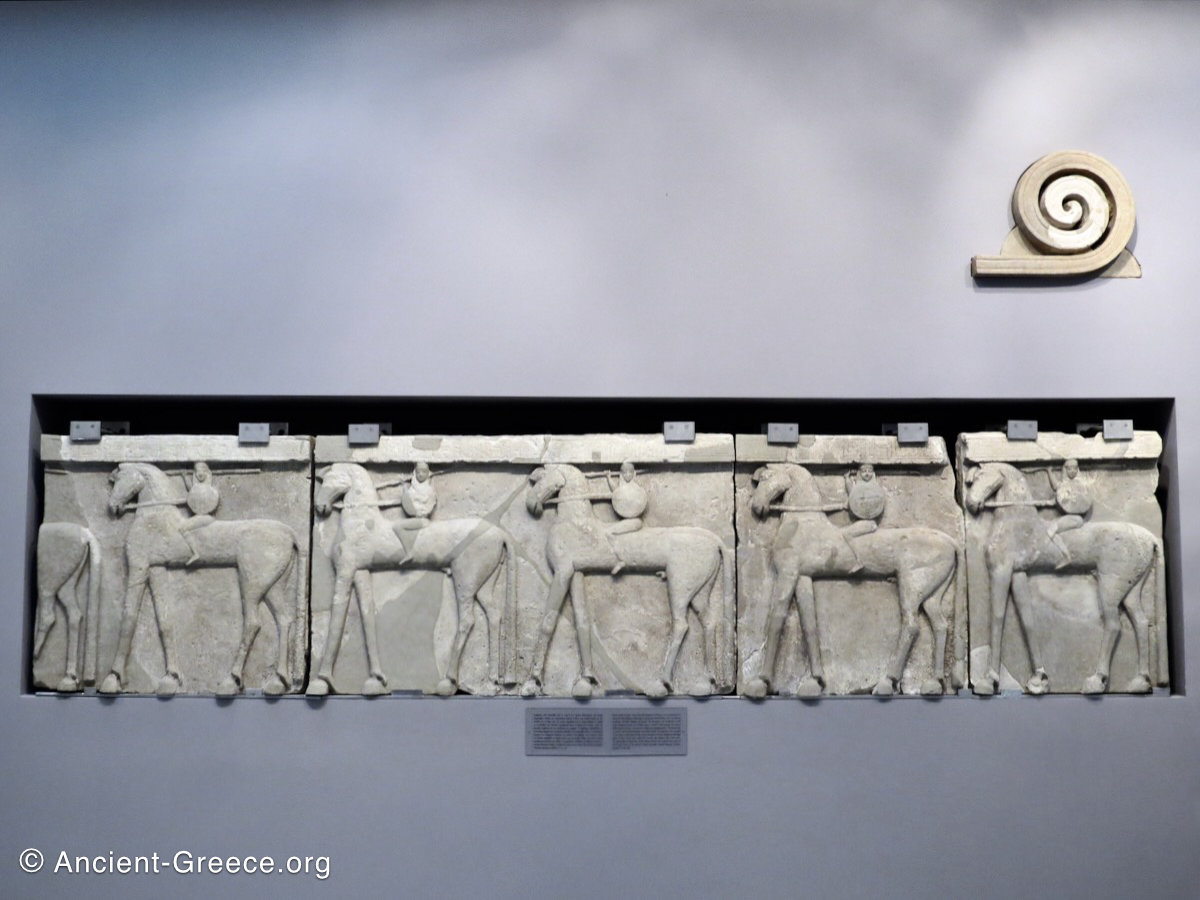
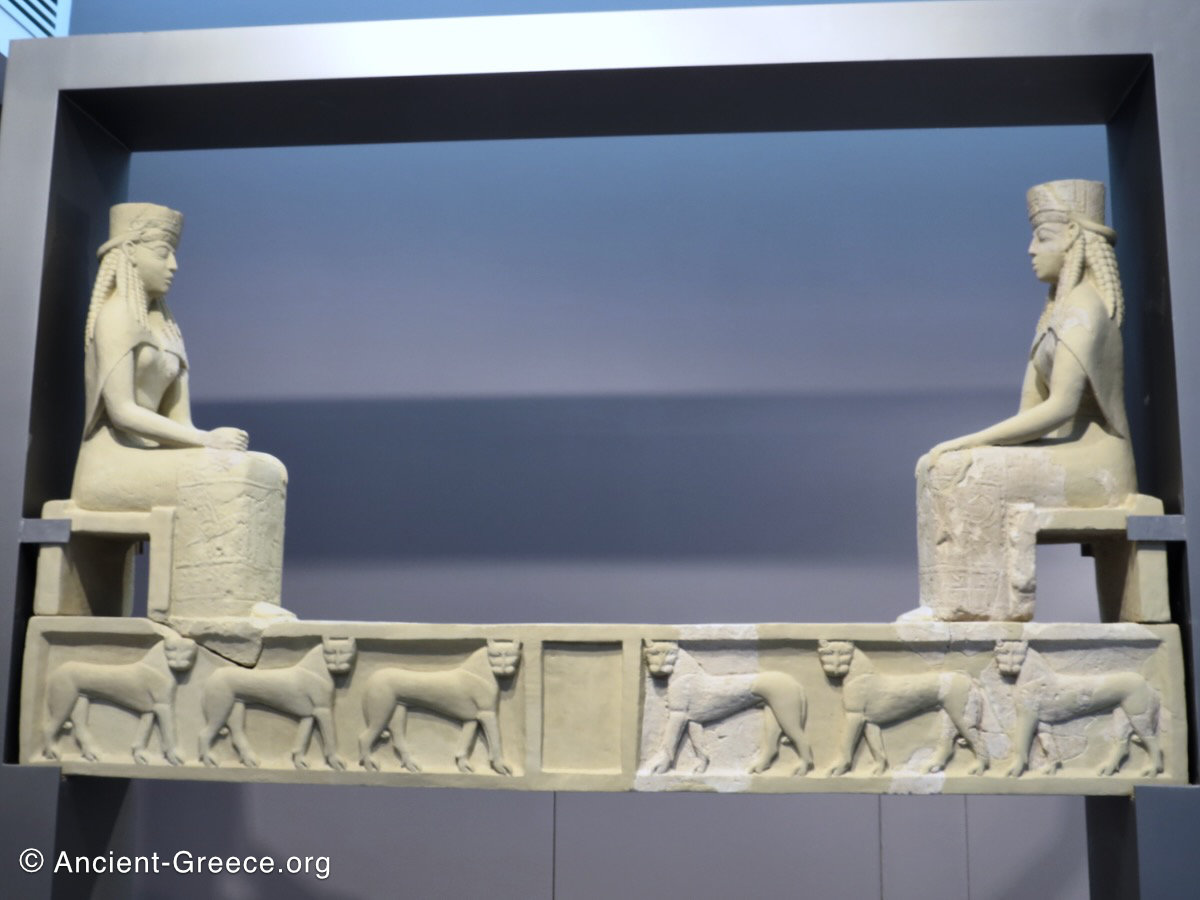
Top row, left to right:
- Aphrodite Marble Statue. Roman. 2nd c. CE.
- Female Torso fragment. Marble.
- Statue fragment of a male torso.
- Peplophoros marble statue. Roman. 2nd c. CE.
Middle row:
- Nymph holding a Basin. Roman. 1st c. CE.
- Marble sculptures on display:
From left to right:
1. Hermes Plutodotes or Kerdoos statue. Roman. 2nd c. CE.
2. Headless kourotrophos statuette. Roman. 3d-2nd c. CE.
3. Female statuette.
4. Female statuette.
5. Poseidon statuette. Roman. 150-175 CE.
6, 7. Female marble statues. - Pottery with chariot.
Bottom row:
- Lintel of Prinias Temple A. 650-600 BCE.
- Frieze of Prinias Temple A. 650-600 BCE.

































































































